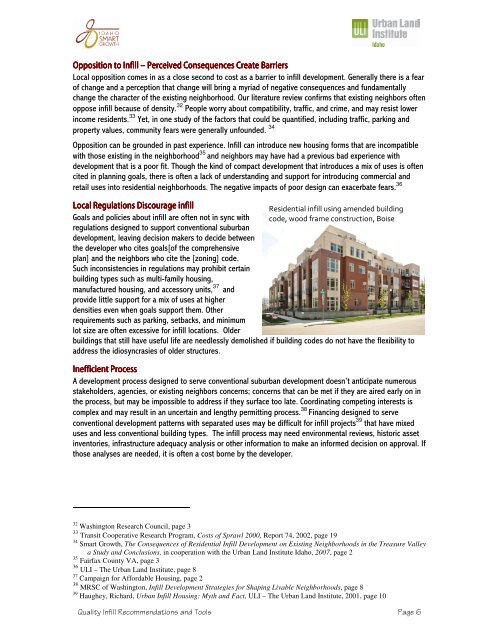Quality Infill Quality Infill - Idaho Smart Growth
Quality Infill Quality Infill - Idaho Smart Growth
Quality Infill Quality Infill - Idaho Smart Growth
Create successful ePaper yourself
Turn your PDF publications into a flip-book with our unique Google optimized e-Paper software.
Opposition Opposition to to <strong>Infill</strong> <strong>Infill</strong> <strong>Infill</strong> – Perceived Perceived Consequences Consequences Create Barriers<br />
Local opposition comes in as a close second to cost as a barrier to infill development. Generally there is a fear<br />
of change and a perception that change will bring a myriad of negative consequences and fundamentally<br />
change the character of the existing neighborhood. Our literature review confirms that existing neighbors often<br />
oppose infill because of density. 32 People worry about compatibility, traffic, and crime, and may resist lower<br />
income residents. 33 Yet, in one study of the factors that could be quantified, including traffic, parking and<br />
property values, community fears were generally unfounded. 34<br />
Opposition can be grounded in past experience. <strong>Infill</strong> can introduce new housing forms that are incompatible<br />
with those existing in the neighborhood 35 and neighbors may have had a previous bad experience with<br />
development that is a poor fit. Though the kind of compact development that introduces a mix of uses is often<br />
cited in planning goals, there is often a lack of understanding and support for introducing commercial and<br />
retail uses into residential neighborhoods. The negative impacts of poor design can exacerbate fears. 36<br />
Local Local Regulations Regulations Discourage Discourage infill<br />
infill<br />
Goals and policies about infill are often not in sync with<br />
regulations designed to support conventional suburban<br />
development, leaving decision makers to decide between<br />
the developer who cites goals[of the comprehensive<br />
plan] and the neighbors who cite the [zoning] code.<br />
Such inconsistencies in regulations may prohibit certain<br />
building types such as multi-family housing,<br />
manufactured housing, and accessory units, 37 and<br />
provide little support for a mix of uses at higher<br />
densities even when goals support them. Other<br />
requirements such as parking, setbacks, and minimum<br />
lot size are often excessive for infill locations. Older<br />
buildings that still have useful life are needlessly demolished if building codes do not have the flexibility to<br />
address the idiosyncrasies of older structures.<br />
Inefficient Inefficient Process<br />
Process<br />
Residential infill using amended building<br />
code, wood frame construction, Boise<br />
A development process designed to serve conventional suburban development doesn’t anticipate numerous<br />
stakeholders, agencies, or existing neighbors concerns; concerns that can be met if they are aired early on in<br />
the process, but may be impossible to address if they surface too late. Coordinating competing interests is<br />
complex and may result in an uncertain and lengthy permitting process. 38 Financing designed to serve<br />
conventional development patterns with separated uses may be difficult for infill projects 39 that have mixed<br />
uses and less conventional building types. The infill process may need environmental reviews, historic asset<br />
inventories, infrastructure adequacy analysis or other information to make an informed decision on approval. If<br />
those analyses are needed, it is often a cost borne by the developer.<br />
32<br />
Washington Research Council, page 3<br />
33<br />
Transit Cooperative Research Program, Costs of Sprawl 2000, Report 74, 2002, page 19<br />
34<br />
<strong>Smart</strong> <strong>Growth</strong>, The Consequences of Residential <strong>Infill</strong> Development on Existing Neighborhoods in the Treasure Valley<br />
a Study and Conclusions, in cooperation with the Urban Land Institute <strong>Idaho</strong>, 2007, page 2<br />
35<br />
Fairfax County VA, page 3<br />
36<br />
ULI – The Urban Land Institute, page 8<br />
37<br />
Campaign for Affordable Housing, page 2<br />
38<br />
MRSC of Washington, <strong>Infill</strong> Development Strategies for Shaping Livable Neighborhoods, page 8<br />
39<br />
Haughey, Richard, Urban <strong>Infill</strong> Housing: Myth and Fact, ULI – The Urban Land Institute, 2001, page 10<br />
<strong>Quality</strong> <strong>Infill</strong> Recommendations and Tools Page 6


